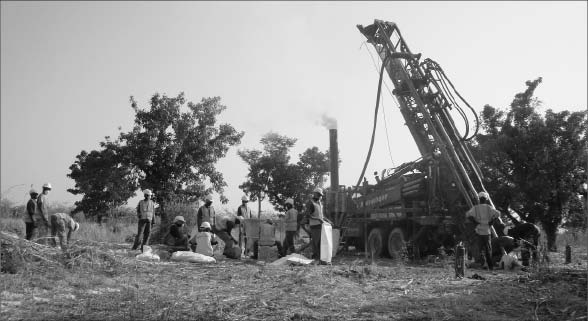Exploration and infill drilling at PMI Gold‘s (PMV-V, PVM-A) past-producing Obotan gold project in southwestern Ghana has turned up 20.8 metres grading 17.6 grams gold per tonne, part of a larger intersection of 80 metres grading 7.49 grams gold. The company is in the midst of a 40,000-metre drill program at Obotan, and intersected the high-grade zone while drilling beneath the base of the former Nkran open pit.
PMI now has two drills turning on the property but hopes to bring in three more rigs by the end of the year, with the first new drill scheduled to arrive in June. The large exploration program should not be a problem for the previously cash-strapped company, as it recently raised $35 million when listing its shares on the Australian Stock Exchange last December.
Obotan last saw production in 2002, when Australia-based Resolute Mining (RSG-A) decided to shut down mining operations there because of the low price of gold at the time, around US$320 an ounce, which made mining the deeper mineralization unprofitable.
Over a six-year mine life, Resolute produced over 730,000 oz. gold from Obotan at compellingly low operating costs given today’s standards. In its last year of production, cash costs at Obotan were just US$172 an oz., with gold recovery, at an impressive 97%.
Resolute noted in a 2002 annual report to shareholders that a “number of measured and indicated resources remain on the Obotan concession but these are not economically exploitable at the current gold price. Potential remains for a small-tonnage underground operation to be established on the Nkran deeps,” referring to the deeper mineralization recently intersected by PMI.
PMI acquired the project from the Ghanaian government in late 2006 (after Resolute had completed mine closure and rehabilitation), though PMI has had trouble advancing the project over the last four years as it kept running out of money.
With that problem now solved, PMI can work on updating the more-than-one-million-ounce inferred gold resource into higher categories. Along with Obotan’s main Nkran deposit, the company controls three smaller, nearby satellite deposits: Abore, Adubiaso and Asuadi.
PMI currently has 185 million shares outstanding, though that is better than the 284 million it had before rolling back its shares 1-to-2 in October to meet ASX listing requirements.
Three shareholders control around 61 million shares. The largest shareholder with 26.1 million shares is Australia-based Macquarie Bank, a large international banking syndicate which bought the shares in 2010 between 28¢ and 36¢ (post roll back). The bank has been buying shares in several West African explorers lately, most notably Perseus Mining (PRU-T, PRU-A) and the Lundin Group’s late Red Back Mining, which Kinross Gold (K-T, KGC-N) took over in a US$7.1-billion deal last year.
The second-largest shareholder, with 19.6 million shares, is Waratah Investments, a private company registered in Ghana and controlled by Australia’s Nicholas Charles Taylor. He is known for vending the Central Ashanti gold project in Ghana to Perseus in 2006, having previously bought it off AngloGold Ashanti (AU-N).
Finally, in third place with 15.5 million PMI shares, comes Arlyn Miller, a private investor from Denver, Colo. He bought 5 million post roll back shares at 10¢ in July 2009, and another 5 million a month later at 20¢. Since mid-2010 he has been taking profits. In February 2011, he sold 1.6 million of his shares between 53¢ and 69¢, and on March 2, the day PMI released its latest Obotan drill results, he sold 900,000 shares between 77¢ and 93¢.


Be the first to comment on "PMI drills high-grade at old Ghanaian mine"